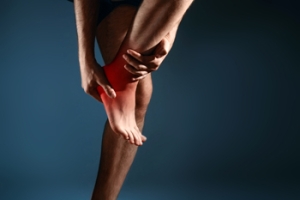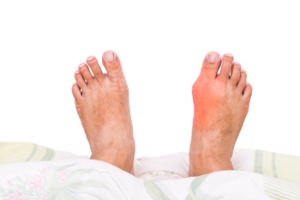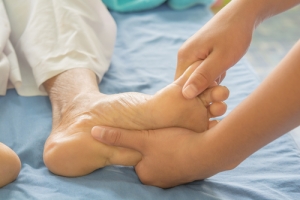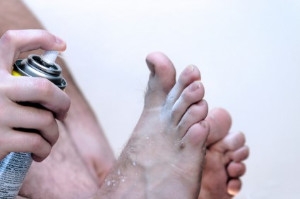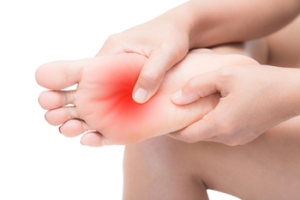
Why do Stress Fractures Develop?
 If you enjoy the sport of running or jogging, you may develop a stress fracture. This may gradually occur from the frequent repetitive motion that accompanies this type of activity. Despite the fact that many people who engage in sports may endure the discomfort of a stress fracture, certain individuals may be prone to developing this ailment. This may include having a medical condition that may weaken the bones, or experiencing a disorder that may affect the nerves. This may result in a loss of feeling. The pain that is associated with this condition may not be felt. The noticeable symptoms may include pain and discomfort and may be more intense in one foot. After an MRI or bone scan is performed, the proper treatment options can be discussed, such as possibly wearing a cast or boot or taking certain medications. Please consult with a podiatrist if you have endured a stress fracture and would like information about correct treatment techniques that are right for you.
If you enjoy the sport of running or jogging, you may develop a stress fracture. This may gradually occur from the frequent repetitive motion that accompanies this type of activity. Despite the fact that many people who engage in sports may endure the discomfort of a stress fracture, certain individuals may be prone to developing this ailment. This may include having a medical condition that may weaken the bones, or experiencing a disorder that may affect the nerves. This may result in a loss of feeling. The pain that is associated with this condition may not be felt. The noticeable symptoms may include pain and discomfort and may be more intense in one foot. After an MRI or bone scan is performed, the proper treatment options can be discussed, such as possibly wearing a cast or boot or taking certain medications. Please consult with a podiatrist if you have endured a stress fracture and would like information about correct treatment techniques that are right for you.
Stress fractures occur when there is a tiny crack within a bone. To learn more, contact one of our podiatrists from PA Foot & Ankle Associates. Our doctors can provide the care you need to keep you pain free and on your feet.
How Are They Caused?
Stress fractures are the result of repetitive force being placed on the bone. Since the lower leg and feet often carry most of the body’s weight, stress fractures are likely to occur in these areas. If you rush into a new exercise, you are more likely to develop a stress fracture since you are starting too much, too soon. Pain resulting from stress fractures may go unnoticed at first, however it may start to worsen over time.
Risk Factors
- Gender – They are more commonly found in women compared to men.
- Foot Problems – People with unusual arches in their feet are more likely to develop stress fractures.
- Certain Sports – Dancers, gymnasts, tennis players, runners, and basketball players are more likely to develop stress fractures.
- Lack of Nutrients – A lack of vitamin D and calcium may weaken the bones and make you more prone to stress fractures
- Weak Bones – Osteoporosis can weaken the bones therefore resulting in stress fractures
Stress fractures do not always heal properly, so it is important that you seek help from a podiatrist if you suspect you may have one. Ignoring your stress fracture may cause it to worsen, and you may develop chronic pain as well as additional fractures.
If you have any questions, please feel free to contact one of our offices located in Allentown, Easton, Northampton, and Chew Street in Allentown, PA . We offer the newest diagnostic and treatment technologies for all your foot care needs.
Stress Fractures of the Foot and Ankle
Our bones are important aspects of our body and they are constantly changing. The heavier the workload for a bone, the more likely it is that calcium will be placed in it. When a bone isn’t used often, there won’t be much calcium within it. When stress from repetitive loads prevent the bone from being able to repair itself, cracks will start to form. Stress fractures are defined as cracks in a bone that result from repetitive force, such as overuse.
The most common cause of stress fractures is a sudden increase in intensity and duration of physical activity. For example, if you begin to run long distances without working your way into doing so, you will be more likely to develop a stress fracture.
Common symptoms of stress fractures are pain and swelling near the weight bearing area on the injured bone. When initial x-rays are performed, it is possible that the fracture will not show up. However, once the stress on the area continues, the damage will increase, and the fracture will be severe enough to show up on an x-ray. Certain parts of the foot are more likely to develop stress fractures than others. Areas that typically have these fractures are: the metatarsals, the navicular bone, the calcaneus, tibia, and fibula.
Since women are at an increased risk of developing osteoporosis, they are twice as likely as men to sustain a stress fracture. Additionally, old age causes a decrease in bone mineral density which is why elderly people are also likely to develop these fractures.
It is important for you to be professionally diagnosed by a podiatrist if you suspect you have a stress fracture, because there are other injuries that can easily be mistaken for a fracture. Sprains, strains, shin splints, plantar fasciitis, and Morton’s neuroma can all easily be mistaken for stress fractures in the foot. Your podiatrist will likely ask you a series of questions to determine what type of pain you are experiencing. These questions will help your doctor identify whether you have a stress fracture.
The best method of treatment for a stress fracture is rest. Additionally, a walking boot, cast, or crutches, will help rest the area that is injured. The typical healing time for stress fractures is 4-12 weeks, however this depends on which bone is involved.
Gout Can Cause Pain and Discomfort
 The painful condition known as gout is considered to be a form of arthritis. Acute gout is often associated with severe pain and discomfort. Additionally, there are some patients who experience swelling and tenderness in the joints of the big toe and surrounding areas. This condition may occur as a result of excess uric acid that is present in the blood levels. Common reasons why gout may develop may be a result of specific types of food that are eaten, which may include shellfish, juices that are sweetened, or red meat. After a proper diagnosis is performed, which may consist of a physical examination, and checking the uric acid levels, the correct treatment can begin. This may include taking specific medications that may help to reduce any inflammation. If you are afflicted with gout, it is strongly suggested that you consult with a podiatrist who can guide you to begin proper treatment and to learn about preventive measures.
The painful condition known as gout is considered to be a form of arthritis. Acute gout is often associated with severe pain and discomfort. Additionally, there are some patients who experience swelling and tenderness in the joints of the big toe and surrounding areas. This condition may occur as a result of excess uric acid that is present in the blood levels. Common reasons why gout may develop may be a result of specific types of food that are eaten, which may include shellfish, juices that are sweetened, or red meat. After a proper diagnosis is performed, which may consist of a physical examination, and checking the uric acid levels, the correct treatment can begin. This may include taking specific medications that may help to reduce any inflammation. If you are afflicted with gout, it is strongly suggested that you consult with a podiatrist who can guide you to begin proper treatment and to learn about preventive measures.
Gout is a painful condition that can be treated. If you are seeking treatment, contact one of our podiatrists from PA Foot & Ankle Associates. Our doctors will treat your foot and ankle needs.
What Is Gout?
Gout is a form of arthritis that is characterized by sudden, severe attacks of pain, redness, and tenderness in the joints. The condition usually affects the joint at the base of the big toe. A gout attack can occur at any random time, such as the middle of the night while you are asleep.
Symptoms
- Intense Joint Pain - Usually around the large joint of your big toe, and it most severe within the first four to twelve hours
- Lingering Discomfort - Joint discomfort may last from a few days to a few weeks
- Inflammation and Redness -Affected joints may become swollen, tender, warm and red
- Limited Range of Motion - May experience a decrease in joint mobility
Risk Factors
- Genetics - If family members have gout, you’re more likely to have it
- Medications - Diuretic medications can raise uric acid levels
- Gender/Age - Gout is more common in men until the age of 60. It is believed that estrogen protects women until that point
- Diet - Eating red meat and shellfish increases your risk
- Alcohol - Having more than two alcoholic drinks per day increases your risk
- Obesity - Obese people are at a higher risk for gout
Prior to visiting your podiatrist to receive treatment for gout, there are a few things you should do beforehand. If you have gout you should write down your symptoms--including when they started and how often you experience them, important medical information you may have, and any questions you may have. Writing down these three things will help your podiatrist in assessing your specific situation so that he or she may provide the best route of treatment for you.
If you have any questions, please feel free to contact one of our offices located in Allentown, Easton, Northampton, and Chew Street in Allentown, PA . We offer the newest diagnostic and treatment technologies for all your foot care needs.
Everything You Need to Know About Gout
Gout, typically found in diabetic patients, is an unusually painful form of arthritis caused by elevated levels of uric acid in the bloodstream. The condition typically strikes the big joint on the big toe. It has also been known to strike the knees, elbows, fingers, ankles and wrists—generally anywhere that has a functioning, moving joint.
The high level of uric acid in a person’s bloodstream creates the condition known as hyperuricema—the main cause of gout. Genetic predisposition occurs in nine out of ten sufferers. The children of parents who suffer gout will have a two in ten chance of developing the condition as well.
This form of arthritis, being particularly painful, is the leftover uric acid crystallizing in the blood stream. The crystallized uric acid then travels to the space between joints where they rub, causing friction when the patient moves. Symptoms include: pain, redness, swelling, and inflammation. Additional side effects may include fatigue and fever, although reports of these effects are very rare. Some patients have reported that pain may intensify when the temperature drops, such as when you sleep.
Most cases of gout are easily diagnosed by a podiatrist’s assessment of the various symptoms. Defined tests can also be performed. A blood test to detect elevated levels of uric acid is often used as well as an x-ray to diagnose visible and chronic gout.
Treatment for gout simply means eliminating symptoms. Non-steroid anti-inflammatory drugs or NSAIDs (Colchicine and other corticosteroid drugs, etc.) will quell the redness, the swelling, and the inflammation. However, managing your diet, lifestyle changes, and using preventative drugs are all helpful toward fully combating the most severe cases.
Those that lead an inactive lifestyle are at a higher risk for gout. Any amount of exercise decreases the probability of repeat encounters with the condition. Reducing your consumption of red meat, sea food, and fructose-sweetened drinks also reduces the likelihood of chronic gout as well.
Ingesting Vitamin C, coffee, and particular dairy products can help with maintaining a healthy lifestyle. There are new drugs out on the market that inhibit the body’s production of uric acid-producing enzymes. However, reducing or eliminating your overall levels of uric acid is the best remedy to ensuring you lead a gout-free life.
Foot Massages Are a Form of Foot Therapy
 Research has indicated that a foot massage is a popular form of foot therapy. Many people enjoy the benefits of this type of therapy, and have realized the positive effects the overall body may enjoy. According to chinese medicine, when pressure is exerted on specific areas of the feet which is referred to as reflexology, it may aid in healing conditions that may be present in the body. Patients who endure chronic pain throughout the body may be helped by the practice of foot massages. Additionally, general pain throughout the body, lower back pain, and anxiety are uncomfortable ailments that may gradually ease when pressure is applied to certain pressure points in the feet. If you would like additional information about the benefits of foot therapy, please consult with a podiatrist who can properly guide you.
Research has indicated that a foot massage is a popular form of foot therapy. Many people enjoy the benefits of this type of therapy, and have realized the positive effects the overall body may enjoy. According to chinese medicine, when pressure is exerted on specific areas of the feet which is referred to as reflexology, it may aid in healing conditions that may be present in the body. Patients who endure chronic pain throughout the body may be helped by the practice of foot massages. Additionally, general pain throughout the body, lower back pain, and anxiety are uncomfortable ailments that may gradually ease when pressure is applied to certain pressure points in the feet. If you would like additional information about the benefits of foot therapy, please consult with a podiatrist who can properly guide you.
Foot therapy is often necessary for those recovering from either foot deformities or foot injuries. If you have concerns regarding therapy, consult with one of our podiatrists from PA Foot & Ankle Associates. Our doctors can provide the care you need to keep you pain-free and on your feet.
Most Common Injuries
People who are active or athletes are prone to a variety of injuries. Therefore, it is often important to take part in physical therapy in order to quickly get back on the right track.
What to Do When Injured
Physical Therapy – This specialized treatment will focus on the affected area, speeding up recovery and the overall healing process. It is a proven method that has helped millions of people return from any injury.
During physical therapy you will undergo regimented training to get back into full form. Training is often very difficult, especially at first when the foot feels weak. Physical therapy often involves:
Basic stretching and twisting exercises – getting the feet’s mobility and flexibility up.
Massaging – the therapist will massage the injured area in order to activate the muscles and relax them.
Strengthening Exercises – this allows the muscles in the affected area to regain their full strength, a vital step towards full recovery.
If you have any questions please feel free to contact one of our offices located in Allentown, Easton, Northampton, and Chew Street in Allentown, PA . We offer the newest diagnostic tools and technology to treat your foot and ankle needs.
Foot Therapy for Sports Injuries
Whether in practice or in the game, athletes put their bodies through great stress. Some sports demand more from the body than others. However, every sport has an element of inorganic movement or unnatural motion. For example, in softball, a pitcher winds up and flings her body with an incredible amount of dexterity in order to get the most ideal velocity out of her pitches. This motion, incredibly taxing on the body, can cause serious injury.
One of the most common issues of athletic injuries happens in the feet. If it’s a damaging fracture that leaves the athlete sidelined or just a simple turf toe, foot injuries can still be very frustrating and painful. Regardless of the sport, athletes still require use of their feet in some fashion. This is why foot therapy is extremely vital for getting athletes back on the right track to return to the field.
No matter the injury, the best way to speed up the recovery period is to receive physical therapy. Physical therapy has proven to work for millions of people. Professional physical therapists are specifically trained to help people return to proper form from any injury.
During physical therapy, you will go through organized training in order to get back into form. Sometimes training can be quite difficult, especially in the beginning when there is more pain and the foot feels awkward. To alleviate this, you will do basic twisting and stretching exercises in order to get flexibility and foot mobility back up. The therapist will also massage the injured area to activate and relax muscles. Over time you will eventually move up to strengthening exercises, designed specifically so that the injured area is exercised.
Foot therapy for sports is a modern science miracle. Unlike other treatments that may employ the use of fancy chemicals and terminology, physical therapy is an evidence-based practice that offers the same benefits. Due to huge advancements in the knowledge of muscles and joints, doctors can turn catastrophic injuries around so that athletes can return to the game once more.
Why Does Athlete’s Foot Occur?
 The condition that is referred to as athlete’s foot is known to be a contagious fungal infection. It may typically occur as a result of fungus entering the feet through tiny cracks in the skin. A perfect environment for this type of fungus to thrive in are warm and moist areas, which may include the inside of shoes and socks. It most commonly affects the space between the toes, and noticeable symptoms may include severe itching and redness, in addition to the skin becoming cracked, which may be painful. It is typically spread by walking barefoot in public pools and surrounding areas, including locker rooms and shower stalls. There may be some patients who have specific medical conditions that may encourage athlete’s foot to develop easier. These may include poor blood circulation, dermatitis, or a genetic trait. If you have any of the symptoms that are associated with athlete’s foot, it is advised to speak to a podiatrist who can properly assist you in choosing the correct treatment.
The condition that is referred to as athlete’s foot is known to be a contagious fungal infection. It may typically occur as a result of fungus entering the feet through tiny cracks in the skin. A perfect environment for this type of fungus to thrive in are warm and moist areas, which may include the inside of shoes and socks. It most commonly affects the space between the toes, and noticeable symptoms may include severe itching and redness, in addition to the skin becoming cracked, which may be painful. It is typically spread by walking barefoot in public pools and surrounding areas, including locker rooms and shower stalls. There may be some patients who have specific medical conditions that may encourage athlete’s foot to develop easier. These may include poor blood circulation, dermatitis, or a genetic trait. If you have any of the symptoms that are associated with athlete’s foot, it is advised to speak to a podiatrist who can properly assist you in choosing the correct treatment.
Athlete’s foot is an inconvenient condition that can be easily reduced with the proper treatment. If you have any concerns about your feet and ankles, contact one of our podiatrists from PA Foot & Ankle Associates. Our doctors will treat your foot and ankle needs.
Athlete’s Foot: The Sole Story
Athlete's foot, also known as tinea pedis, can be an extremely contagious foot infection. It is commonly contracted in public changing areas and bathrooms, dormitory style living quarters, around locker rooms and public swimming pools, or anywhere your feet often come into contact with other people.
Solutions to Combat Athlete’s Foot
- Hydrate your feet by using lotion
- Exfoliate
- Buff off nails
- Use of anti-fungal products
- Examine your feet and visit your doctor if any suspicious blisters or cuts develop
Athlete’s foot can cause many irritating symptoms such as dry and flaking skin, itching, and redness. Some more severe symptoms can include bleeding and cracked skin, intense itching and burning, and even pain when walking. In the worst cases, Athlete’s foot can cause blistering as well. Speak to your podiatrist for a better understanding of the different causes of Athlete’s foot, as well as help in determining which treatment options are best for you.
If you have any questions please feel free to contact one of our offices located in Allentown, Easton, Northampton, and Chew Street in Allentown, PA . We offer the newest diagnostic and treatment technologies for all your foot and ankle needs.
How to Deal with Athlete's Foot
Athlete’s foot is a type of fungal infection that affects the skin on the feet. It is caused when the tinea fungus grows on the foot. It is possible to catch the fungus through direct contact with someone who has it or by touching a surface that is contaminated with it. This type of fungus thrives in warm, moist environments such as showers, locker room floors, and swimming pools. Your risk of getting it may also increase by wearing tight-fitting, closed-toe shoes, or by having sweaty feet.
Symptoms of athlete’s foot include itching, stinging or burning sensations between the toes. You may also experience toenails that are discolored, thick, crumbly, or toenails that pull away from the nail bed.
Your podiatrist may diagnose athlete’s foot by detecting these symptoms or by doing a skin test to see if there is a fungal infection present. The most common exam used to detect Athlete’s foot is a skin lesion potassium hydroxide exam. To use this method, your doctor will scrape off a small area of the infected skin and place it into potassium hydroxide. The potassium hydroxide will destroy the normal cells and leave the fungal cells untouched so that they are visible under a microscope.
There are a variety of treatment options for athlete’s foot. Some medications are miconazole (Desenex), terbinafine (Lamisil AT), clotrimazole (Lotrimin AF), butenafine (Lotrimin Ultra), and tolnaftate (Tinactin). While these options may be able to treat your fungus, it is best that you consult with a podiatrist in order to see which treatment option may work best for you.
In some cases, Athlete’s foot may lead to complications. A severe complication would be a secondary bacterial infection which may cause your foot to become swollen, painful, and hot.
There are ways that you can prevent athlete’s foot. Washing your feet with soap and water each day and drying them thoroughly is an effective way to prevent infections. You also shouldn’t share socks, shoes, or towels with other people. It is crucial that you wear shower sandals in public showers, around swimming pools, and in other public places. Additionally, you should make sure you wear shoes that can breathe and change your socks when your feet become sweaty. If you suspect that you have Athlete’s foot, you should seek help from a podiatrist as soon as possible.
What Causes Tarsal Tunnel Syndrome?
 The area in the foot that is located between bones and fibrous tissue is known as the tarsal tunnel. There are several nerves, arteries, veins, and tendons that lie inside this portion of the foot. If these nerves should be compressed, inflammation may occur and may be indicative of a condition that is referred to as tarsal tunnel syndrome. This uncomfortable ailment may be the result of different forms of arthritis, tumors that may be benign, or from a possible fracture. Additionally, medical conditions including flat feet or specific foot deformities can cause narrowing of this “tunnel” and may precede the onset of this condition. Patients will typically be aware of noticeable symptoms that may include numbness or tingling over the sole of the foot, in addition to pain and a burning sensation. If you feel you may have tarsal tunnel syndrome, it is advised to consult with a podiatrist who can perform a proper diagnosis and discuss correct treatment options.
The area in the foot that is located between bones and fibrous tissue is known as the tarsal tunnel. There are several nerves, arteries, veins, and tendons that lie inside this portion of the foot. If these nerves should be compressed, inflammation may occur and may be indicative of a condition that is referred to as tarsal tunnel syndrome. This uncomfortable ailment may be the result of different forms of arthritis, tumors that may be benign, or from a possible fracture. Additionally, medical conditions including flat feet or specific foot deformities can cause narrowing of this “tunnel” and may precede the onset of this condition. Patients will typically be aware of noticeable symptoms that may include numbness or tingling over the sole of the foot, in addition to pain and a burning sensation. If you feel you may have tarsal tunnel syndrome, it is advised to consult with a podiatrist who can perform a proper diagnosis and discuss correct treatment options.
Tarsal tunnel syndrome can be very uncomfortable to live with. If you are experiencing tarsal tunnel syndrome, contact one of our podiatrists of PA Foot & Ankle Associates. Our doctors can provide the care you need to keep you pain-free and on your feet.
Tarsal Tunnel Syndrome
Tarsal tunnel syndrome, which can also be called tibial nerve dysfunction, is an uncommon condition of misfiring peripheral nerves in the foot. The tibial nerve is the peripheral nerve in the leg responsible for sensation and movement of the foot and calf muscles. In tarsal tunnel syndrome, the tibial nerve is damaged, causing problems with movement and feeling in the foot of the affected leg.
Common Cause of Tarsal Tunnel Syndrome
- Involves pressure or an injury, direct pressure on the tibial nerve for an extended period of time, sometimes caused by other body structures close by or near the knee.
- Diseases that damage nerves, including diabetes, may cause tarsal tunnel syndrome.
- At times, tarsal tunnel syndrome can appear without an obvious cause in some cases.
The Effects of Tarsal Tunnel Syndrome
- Different sensations, an afflicted person may experience pain, tingling, burning or other unusual sensations in the foot of the affected leg.
- The foot muscles, toes and ankle become weaker, and curling your toes or flexing your foot can become difficult.
- If condition worsens, infections and ulcers may develop on the foot that is experiencing the syndrome.
A physical exam of the leg can help identify the presence of tarsal tunnel syndrome. Medical tests, such as a nerve biopsy, are also used to diagnose the condition. Patients may receive physical therapy and prescriptive medication. In extreme cases, some may require surgery.
If you have any questions please feel free to contact one of our offices located in Allentown, Easton, Northampton, and Chew Street in Allentown, PA . We offer the newest diagnostic and treatment technologies for all your foot and ankle needs.
Tarsal Tunnel Syndrome
Tarsal tunnel syndrome is a condition in which there is a compression of the posterior tibial nerve. The posterior tibial nerve runs along the inside of the ankle into the foot. Tarsal tunnel syndrome is named for the tarsal tunnel, which is a thin space along the inside of the ankle beside the ankle bones. This space contains various nerves, arteries, and tendons, and includes the posterior tibial nerve. The tibial nerve is the peripheral nerve in the leg responsible for sensation and movement of the foot and calf muscles. In tarsal tunnel syndrome the tibial nerve is compressed, causing tingling or burning, numbness, and pain.
Common causes of tarsal tunnel syndrome involve pressure or an injury. Injuries that produce inflammation and swelling in or around the tunnel may place pressure on the posterior tibial nerve. Direct pressure on the tibial nerve for an extended period of time, sometimes caused by other body structures close by or trauma to the tibial nerve, can result in tarsal tunnel syndrome. Diseases that damage nerves, such as diabetes or arthritis, may cause tarsal tunnel syndrome. Those with flat feet are at risk for developing the condition, as the extra pressure and strain placed on the foot may compress the posterior tibial nerve.
Feeling different sensations in the foot at different times is a common symptom of tarsal tunnel syndrome. An afflicted person may experience pain, tingling, burning or other unusual sensations in the foot of the affected leg. Symptoms are primarily felt on bottom of the foot and/or the inside of the ankle. Symptoms can appear suddenly and may occur due to overuse of the foot.
To diagnose tarsal tunnel syndrome, your podiatrist may examine the foot and tap the posterior tibial nerve to see if symptoms surface. He or she may also order an MRI to determine if a mass is present.
Treating tarsal tunnel syndrome will depend on the decision of your podiatrist. Multiple options are available, however, and can include rest, ice, immobilization, oral medications such as anti-inflammatory drugs (NSAIDS), physical therapy, injection therapy, orthotics, supportive shoes, braces, and surgery.
